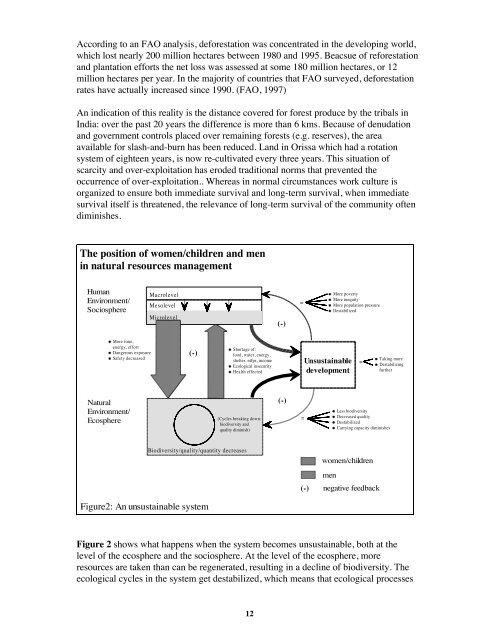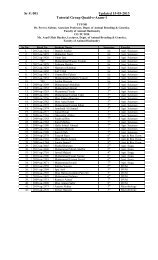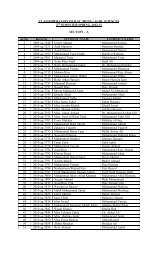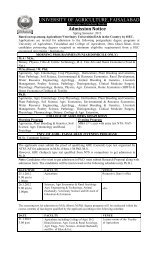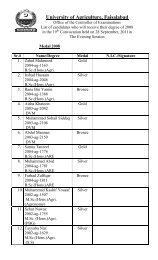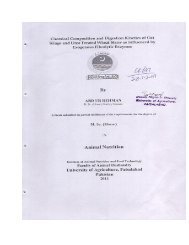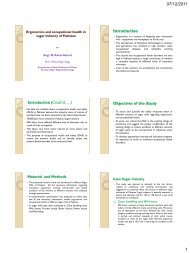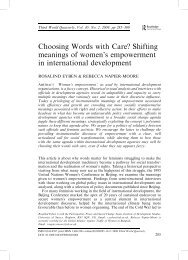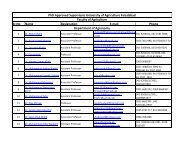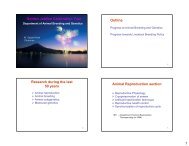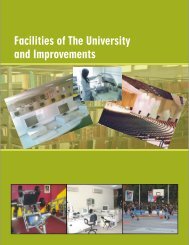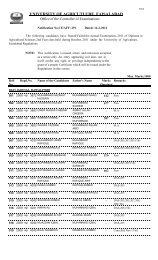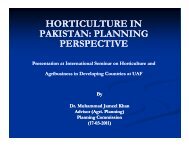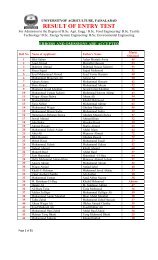Accord<strong>in</strong>g to an FAO analysis, deforestation was concentrated <strong>in</strong> <strong>the</strong> develop<strong>in</strong>g world,which lost nearly 200 million hectares between 1980 and 1995. Beacsue of reforestationand plantation efforts <strong>the</strong> net loss was assessed at some 180 million hectares, or 12million hectares per year. In <strong>the</strong> majority of countries that FAO surveyed, deforestationrates have actually <strong>in</strong>creased s<strong>in</strong>ce 1990. (FAO, 1997)An <strong>in</strong>dication of this reality is <strong>the</strong> distance covered for forest produce by <strong>the</strong> tribals <strong>in</strong>India: over <strong>the</strong> past 20 years <strong>the</strong> difference is more than 6 kms. Because of denudationand government controls placed over rema<strong>in</strong><strong>in</strong>g forests (e.g. reserves), <strong>the</strong> areaavailable for slash-and-burn has been reduced. Land <strong>in</strong> Orissa which had a rotationsystem of eighteen years, is now re-cultivated every three years. This situation ofscarcity and over-exploitation has eroded traditional norms that prevented <strong>the</strong>occurrence of over-exploitation.. Whereas <strong>in</strong> normal circumstances work culture isorganized to ensure both immediate survival and long-term survival, when immediatesurvival itself is threatened, <strong>the</strong> relevance of long-term survival of <strong>the</strong> community oftendim<strong>in</strong>ishes.The position of women/children and men<strong>in</strong> natural resources managementHumanEnvironment/SociosphereMacrolevelMesolevelMicrolevel(-)=More povertyMore <strong>in</strong>equityMore population pressureDestabilizedMore time,energy, effortDangerous exposureSafety decreased(-)Shortage of:food, water, energy,shelter, ntfps, <strong>in</strong>comeEcological <strong>in</strong>securityHealth effectedUnsusta<strong>in</strong>abledevelopment=Tak<strong>in</strong>g moreDestabiliz<strong>in</strong>gfur<strong>the</strong>rNaturalEnvironment/Ecosphere(Cycles break<strong>in</strong>g down:biodiversity andquality dim<strong>in</strong>ish)(-)=Less biodiversityDecreased qualityDestabilizedCarry<strong>in</strong>g capacity dim<strong>in</strong>ishesBiodiversity/quality/quantity decreaseswomen/childrenmen(-) negative feedbackFigure2: An unsusta<strong>in</strong>able systemFigure 2 shows what happens when <strong>the</strong> system becomes unsusta<strong>in</strong>able, both at <strong>the</strong>level of <strong>the</strong> ecosphere and <strong>the</strong> sociosphere. At <strong>the</strong> level of <strong>the</strong> ecosphere, moreresources are taken than can be regenerated, result<strong>in</strong>g <strong>in</strong> a decl<strong>in</strong>e of biodiversity. Theecological cycles <strong>in</strong> <strong>the</strong> system get destabilized, which means that ecological processes12
<strong>in</strong>volv<strong>in</strong>g natural resources such as water, soil, and species are disturbed. As well, morepollution is added to <strong>the</strong> system than it can handle. In o<strong>the</strong>r words, its qualitydim<strong>in</strong>ishes.At <strong>the</strong> same time it is observed that <strong>the</strong> sociosphere becomes destabilized. Inequityamong people <strong>in</strong>creases, as does poverty, and <strong>the</strong> dynamic social relationships betweenlevels (macro and micro) and among levels (with<strong>in</strong> a society, family etc.) getsdisturbed. Social dysfunction<strong>in</strong>g and cultural discont<strong>in</strong>uity occur. At social level suchdevelopments are also reflected <strong>in</strong> chang<strong>in</strong>g power relations at gender level. Women’saccess to and control over (natural) resources and technology gets often more limitedthan that of male members of household. In <strong>the</strong>se situations women lose control and arebe<strong>in</strong>g marg<strong>in</strong>alized and excluded even more.In this situation, which is often <strong>the</strong> reality of today, women and children have to put <strong>in</strong>more time, energy and effort <strong>in</strong>to meet<strong>in</strong>g <strong>the</strong>ir family’s basic needs for naturalresources, security and health. However, as <strong>the</strong> ecosphere cannot supply enough and <strong>the</strong>natural cycles that susta<strong>in</strong> life are disturbed, this task becomes more difficult andsometimes even impossible. Because <strong>the</strong>y have to walk longer distances over rough ordisturbed terra<strong>in</strong> - sometimes overnight - women’s work and life become unsafe. With<strong>the</strong> forests reced<strong>in</strong>g 4-8 km, most village women have to walk for at least one hour and<strong>in</strong> many cases up to two hours each way <strong>in</strong> <strong>the</strong> Ganjam areas <strong>in</strong> India. (Fernandes &Menon, 1987) In parts of <strong>the</strong> Himalayas and <strong>the</strong> African Sahel women and childrenspend 100 to 300 days a year on ga<strong>the</strong>r<strong>in</strong>g fuelwood now. (Wickramas<strong>in</strong>ghe, 1994) Astudy executed <strong>in</strong> Nepal learned that <strong>in</strong> a degrad<strong>in</strong>g environment, with forest covergo<strong>in</strong>g down by more than a half <strong>in</strong> <strong>the</strong> past 20 years, heavy ra<strong>in</strong>fall and land slides andfloods, particularly girls lives have been adversely effected. Whereas developmentprograms were started to enable more girls to attend primary schools, <strong>the</strong> scarcity ofnatural resources and <strong>the</strong> time and energy needed <strong>in</strong> collect<strong>in</strong>g and manag<strong>in</strong>g <strong>the</strong>se,even resulted <strong>in</strong> a decrease <strong>in</strong> girls’ school enrollment. (Johnson et al, 1995)“ You people <strong>in</strong> <strong>the</strong> cities do not know how village women like use have to slog. As <strong>the</strong>farmer forces his bullocks to labor, poverty forces us to labor all <strong>the</strong> time…….. Oneside is gett<strong>in</strong>g <strong>in</strong>flated while <strong>the</strong> o<strong>the</strong>r is shr<strong>in</strong>k<strong>in</strong>g. The section that is shr<strong>in</strong>k<strong>in</strong>g isgett<strong>in</strong>g destroyed.” (CWDS, 1991)While women’s work <strong>in</strong> <strong>the</strong> traditional economic activities became more difficult, <strong>the</strong>addition of new roles <strong>in</strong> settled agriculture and wage labor has placed an immenseextra responsibility on <strong>the</strong>ir shoulders. While more had been added, none has beentaken away. Women’s workload becomes altoge<strong>the</strong>r too great because <strong>the</strong>y have tocomb<strong>in</strong>e <strong>the</strong>ir - more difficult - ‘ma<strong>in</strong>’ and ‘extension’ tasks with <strong>the</strong>ir traditional ones,such as child-rear<strong>in</strong>g. In Sri Lanka expansion of commercial agriculture, such astobacco, <strong>in</strong> village economies has <strong>in</strong>creased <strong>the</strong> pressure on women and createddependence on food from <strong>the</strong> market and <strong>the</strong> necessity to earn money for this bywork<strong>in</strong>g as laborers for wages 20-30% lower than those of men. High consumption offuelwood <strong>in</strong> cur<strong>in</strong>g tobacco has <strong>in</strong>creased land degradation and <strong>the</strong> pressure onresources: about 4,000 kg of fuelwood is used for cur<strong>in</strong>g 1,000 kg of tobacco. Women’ssleep<strong>in</strong>g time <strong>in</strong> peak agriculture seasons was reduced to about five hours, a and about13


